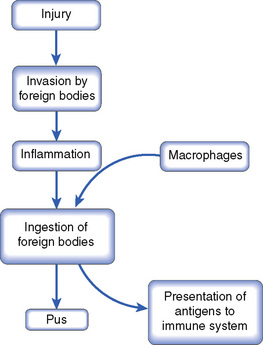24 Non-specific resistance and the immune system
Inflammation
If the skin is cut (see Chapter 23) then chemicals are released from the damaged tissue; these initiate an inflammatory response (Fig. 24.1). Inflammation can be identified by four cardinal signs:
and sometimes loss of function.
The outcome of the inflammatory response is that vasodilation (swelling of blood vessels) takes place. This increases their permeability, and macrophagocyte cells migrate to the site of the injury. The macrophagocyte cells include monocytes and neutrophils and these are responsible for ingesting foreign bodies and destroying them. The inflammatory response is also necessary for the initiation of wound healing (see Chapter 23). The basophil cells, which are called mast cells when they are in the skin, play a part in this inflammatory response by releasing histamine, which leads to inflammation.
The immune system
There are two types of immunity:
< div class='tao-gold-member'>
Stay updated, free articles. Join our Telegram channel

Full access? Get Clinical Tree



